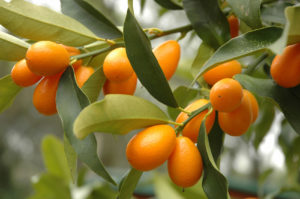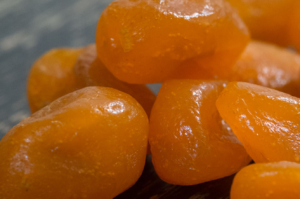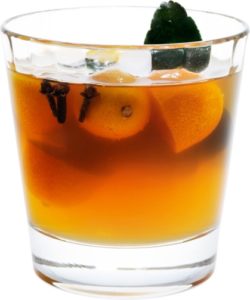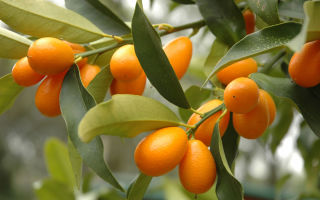Content
- 1 What is this fruit
- 2 Chemical composition and calorie content of kumquat
- 3 How is kumquat useful?
- 4 At what age can kumquat be given to a child
- 5 Kumquat during pregnancy and breastfeeding
- 6 Folk recipes with kumquat for the treatment of diseases
- 7 The benefits and harms of dried kumquat
- 8 Useful properties of dried kumquat
- 9 Can kumquat provoke cystitis
- 10 How to eat kumquat
- 11 What can be cooked from kumquat
- 12 The use of kumquat in cosmetology
- 13 Kumquat harm and contraindications
- 14 How to choose and store a kumquat
- 15 Conclusion
The benefits and harms of kumquat for humans are individual in each case. When adding a healthy exotic fruit to your diet, it is necessary to take into account not only the unique vitamin composition of unusual food, but also the general state of health, the presence of chronic diseases, allergic reactions and other abnormalities in health, so as not to harm your body.
What is this fruit

Kumquat, translated from Japanese as "golden orange", is a type of citrus fruit native to China. The evergreen plant with its small, aromatic, bright orange fruits has already become popular in Europe for its flavor and health benefits.
Kinkan (second name for kumquat) is a unique fruit with a rich vitamin composition.
Chemical composition and calorie content of kumquat
The variety of vitamins in exotic kumquat deserves special attention: in addition to A, ascorbic acid (C), tocopherol (E), it contains the entire group of B vitamins: thiamine, riboflavin, pyridoxine, folic acid.
Omega-3, 6, 9 fatty acids in the composition make kumquat useful for normalizing brain activity. Essential oils in the peel of kinkan have a beneficial effect on the emotional state, soothe the nerves.
Potassium, iron, magnesium, phosphorus, zinc, calcium, manganese, with which kumquat is saturated, are a necessary set of useful elements for the functioning of internal organs and the body as a whole.
The calorie content of fresh kumquat per 100 grams of the product is 71.4 kcal, dried fruit contains 285 kcal, and candied fruits - 250 kcal. This property allows the use of kumquat in dietary nutrition.
How is kumquat useful?
The benefits of kumquat for human health are determined by its composition and positive effect on the functioning of internal organs and systems.
The benefits of fresh kumquat for humans:
- activates the protective properties of the body;
- creates a barrier to the penetration of infections and the development of inflammation;
- lowers cholesterol levels;
- prevents the development of sclerotic changes;
- strengthens hair, nails, improves skin condition;
- relieves joint pain;
- relieves depression, improves mood;
- increases concentration and attention;
- helps to maintain a normal weight without harm to the body.

Kumquat is recognized as a dietary product, this is its benefit for people suffering from various stages of obesity. Such a healthy delicacy is also suitable for those who simply monitor their figure and weight.
It is recommended to include kumquat in the diet for people whose lifestyle is associated with vigorous activity, emotional and physical stress, not without harm affecting their health. Useful properties help to maintain normal vitality, cope with nervous or psychological stress.
For eyes
Harm to the body with a deficiency of vitamins A and E is a violation of the functioning of the organs of vision. Ophthalmologists advise to eat daily 50-100 grams of useful kumquat for the prevention and treatment of eye diseases.
Fatigue, eye inflammation, caused by frequent exposure to a computer screen, relieves the regular use of kumquat for 14 days. This course is carried out 5-6 times a year. The benefits of treatment are marked by improved visual acuity, lack of eye discomfort.
For the heart and blood vessels
A high percentage of useful ascorbic acid in kumquat strengthens the walls of blood vessels, makes them elastic. Cholesterol levels are effectively reduced by alcoholic kinkan tincture.
Kumquat prevents the risk of developing pathological changes in the cardiovascular system, violations of its work.
With diabetes
Using a moderate amount of fresh kumquat or infusions from it can avoid the complications of a serious illness such as diabetes. The recommended amount of consumption without harm to digestion is 100–150 g of kinkan 1–2 times a week.
Sugar-cured fruits, dried with added sugar, can harm the health of a diabetic.
At what age can kumquat be given to a child
It is recommended to add citrus or other exotic fruits to baby food after consulting a pediatrician. It is better to start with a small piece or a few drops of kumquat juice when the child is 3 years old. Even in the absence of side effects, the dose should not be increased sharply. For a baby, it is enough to eat 1-2 pieces per week so as not to harm the developing body.
Kumquat during pregnancy and breastfeeding
Pregnant women and nursing mothers should be careful when introducing kumquat into their menu. It is recommended to start eating the fruit with a small dose, carefully observe the body's reaction to a new product. If you experience an allergic rash, redness or itching of the skin, you should stop taking it.
Discomfort will be experienced not only by a woman, such a condition can negatively affect the health or development of the baby.
In the absence of a negative reaction, it is useful to add kumquat to the diet in moderate doses.
Folk recipes with kumquat for the treatment of diseases
The beneficial properties of golden orange have long been noticed by traditional healers in many countries of the world.
Tincture of kumquat with honey
The combination of the beneficial qualities of citrus and honey in the drink explains the healing properties of the tincture. The benefits are obvious for dry coughs, sore throats. Kumquat suppresses inflammation in the bronchi and lungs.
To prepare kumquat tincture, you need to take:
- fruits of the golden orange - 10 pcs.;
- May honey - 0.5 l;
- vodka - 1 bottle.
Preparation:
- Select whole ripe fruits, rinse, dry on a paper towel.
- Take a liter jar, pour over boiling water or steam sterilize.
- Put the kumquat in a jar, pour over it with liquid honey, then pour the vodka into it.
- Close with a lid, put away in a cool place without access to sunlight.
- Insist 90 days.
- During this time, the contents of the jar must be shaken periodically - 3-4 times for the entire period.
Adding crushed ginger root (50–70 g) to the components of kumquat tincture will significantly increase the bactericidal properties of this natural remedy.
It is recommended to take 1 tablespoon 3 times a day before meals, diluting the tincture in 100 ml of still pure water.An overdose of a medication can be harmful and cause side effects.
Kumquat tea
Herbal medicinal tea for brewing healthy medicinal tea from kumquat can be purchased at the pharmacy chain. It is produced according to the ancient technology of Chinese medicine, it contains only natural, environmentally friendly components.
Ready-made tea with kumquat has an unusual soft sweetish taste, exotic aroma, a whole list of medicinal properties.
A healthy kumquat herbal drink can be made at home.
For this you will need:
- dried kumquat - 15 pcs.;
- dates - 20 pcs.;
- Japanese chrysanthemum flowers - 2 tbsp. spoons;
- hawthorn - 15 pcs.;
- field mint - 2 tbsp. spoons;
- medlar - 10 pcs.;
- pure green tea - 5 tbsp. spoons.
All dry components are ground and mixed.

Take tea from kumquat 2 times a day, brewing 1 tablespoon of the mixture in a glass of boiling water. The date is put in tea just before consumption. For sweetness, add cane sugar if desired.
The benefits of tea:
- relieves mental stress, reduces nervousness, irritability;
- stimulates the process of blood supply to organs;
- improves cerebral circulation, activates memory;
- normalizes digestion processes;
- lowers blood cholesterol levels.
Kumquat decoction
For colds, acute respiratory infections, viral diseases of the upper respiratory tract, a useful decoction from kumquat will help to enhance the effect of medications and shorten the recovery period.
- Fresh (or dried) kumquat is crushed, poured with boiling water (1 tablespoon of raw materials per 2520 ml of water).
- Stand in a water bath for 5-7 minutes.
- To the broth, cooled to a temperature of 60 ° C, add 1 dessert spoon of honey.
They drink a vitamin broth 3 times a day, constantly brewing a new portion.
The benefits and harms of dried kumquat
The benefits and harms of kumquat for the human body are incomparable. Dried fruits are valued no less than fresh fruits. Dried fruits replenish the deficiency of vitamins and mineral compounds, thereby effectively strengthening the body's immune forces to fight bacteria, fungal and viral infections, while not harming the digestive system.
For colds and coughs, the benefits of dried kumquat fruit are enhanced when consumed with the peel, which contains many essential oils.

The benefits of dried orange kumquat are high in fiber, which speeds up the processing of food, stimulates the production of enzymes in gastric juice.
Dried kumquat skin is used for inhalation for respiratory infections, as well as for disinfecting indoor air.
Useful properties of dried kumquat
Dried kumquat retains the entire composition of minerals and vitamins, while it is less caloric than dried fruit.
The active substances of kumquat have a beneficial effect on the skin, preserve its freshness, inhibit the aging process, have useful properties to smooth out fine facial wrinkles and effectively lighten freckles.
Patients with vision problems who regularly use kumquat note the benefits of dried kumquat in slowing down the destructive processes, restoring lost functions.

Can kumquat provoke cystitis
If the acid-base balance is disturbed, favorable conditions are created for the development of pathogenic bacteria.
In patients with a chronic course of cystitis, overeating kumquat can provoke an exacerbation of the disease or the development of an attack. There is no unequivocal opinion about the influence of kumquat on the development of the disease. Sometimes cystitis can manifest itself when eating citrus fruits, but, in general, these two factors are not related to each other and the harm of kumquat has not been proven.
How to eat kumquat
The fruit is consumed in any form. Golden orange has the ability to retain beneficial properties, taste and aroma after heat treatment.
Fresh, ripe kumquats are good to eat whole, with zest, to get the full range of nutrients.
What can be cooked from kumquat
Various useful sweets are prepared from kumquat:
- marmalade;
- jelly;
- jam;
- ice cream;
- marshmallow;
- candied fruit.
Aromatic, with a citrus flavor, pies and muffins are obtained with the addition of the product to the dough or filling.

The benefits of candied kumquat fruits are noted when added to various cocktails, wines or other alcoholic beverages. Mulled wine made from cranberries with kumquat has a useful property to relieve inflammation in case of sore throat and colds, to give tone to a weakened body.

Sauces with kumquat add an exotic taste to meat, fish dishes, vegetable and fruit salads.
The use of kumquat in cosmetology
Due to the beneficial property of kumquat, it effectively whitens the skin and lightens age spots without harming blood vessels, it is used as a natural component in special whitening face creams.
The benefits of treating the face with fresh kumquat juice are noticeable already after the first procedure: the skin becomes lighter by 30–35%.
Kumquat has a beneficial effect on the skin:
- protects from the harmful effects of sunlight;
- prevents the appearance of wrinkles, age-related pigmentation;
- improves the external and internal condition of the skin;
- makes it soft, tight, elastic.
The kumquat peel contains beneficial essential oils widely used in aromatherapy. A few drops of kumquat oil, added to creams or lotions, tone the skin, give it elasticity, and help eliminate toxins and harmful substances.
A few drops of kumquat essential oil will improve the properties of the shampoo or hair mask: the hair will become soft, shiny, its growth will be activated, and the roots will strengthen.
Kumquat harm and contraindications
Eating large amounts of kumquat can be harmful to health in the form of an allergic reaction or acid imbalance.
Such a failure threatens the development of diseases of the digestive tract, exacerbation of chronic diseases.
Contraindications for eating kumquat:
- individual intolerance;
- stomach diseases;
- increased acidity;
- chronic diseases of the digestive tract in the acute stage;
- 2nd and 3rd trimesters of pregnancy;
- allergy to citrus;
- diabetes mellitus (applies to candied, dried and dried fruits).
How to choose and store a kumquat
If you put a kumquat in the freezer, it will not lose its useful properties, and its shelf life will increase. Without losing its benefits, kumquat syrup can be stored in the refrigerator for a long time.
The kumquat for freezing must be prepared as follows:
- select, rinse undamaged fruits;
- prepare syrup: boil 500 g of granulated sugar and 0.5 liters of water;
- dip the fruits in chilled syrup, leave for 3 hours;
- drain the syrup, store the fruit in a sealed glass container.
Conclusion
The benefits and harms of kumquat for the human body are assessed taking into account individual characteristics, genetic predisposition, age, and the presence of diseases. Sunny orange is a valuable dietary and simply delicious citrus that will compensate for the deficiency of vitamins and minerals in the body, improve natural defenses, and give vigor and strength. In the absence of contraindications for health reasons, doctors recommend including kumquat in the diet for therapeutic and prophylactic purposes.

